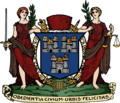St. Michan's Church, Dublin
St. Michan's Church /ˈmaɪˌkən/ is a Church of Ireland church located in Church Street, Dublin, Ireland. The first Christian chapel on this site dated from 1095, and operated as a Catholic church until the Reformation.[4] The current church dates from 1686, and has served Church of Ireland parishioners in Dublin for more than 300 years. The church is known for its vaults, which contain a number of 'mummified' remains.[5] In 2019, a man broke into the church's crypt and stole the heads of two mummies, including that of an 800-year-old body called "The Crusader".[6] While the heads were subsequently recovered,[6] a fire set in the crypt in June 2024 resulted in the destruction of five mummies, including "The Crusader".[7] BuildingBuilt on the site of an early Norse chapel from 1095, the current structure dates largely from a reconstruction undertaken under William Robinson in 1686,[4] but is still the only parish church on the north side of the Liffey surviving from a Viking foundation. While the exterior of the church may be modest, the interior boasts some fine woodwork, and an organ (dated 1724) on which Handel is said to have composed his Messiah.[8] VaultsIntermentsThe vaults of St. Michan's uniquely contain many mummified remains.[3] The walls in the vaults contain limestone, which has kept the air dry, creating ideal conditions for preservation.[9] The remains preserved in the vaults have included the 400-year-old body of a nun, a six-and-a-half-foot man popularly believed to have been a crusader, a body with its feet and right hand severed, and the Sheares brothers—Henry and John—who took part in the 1798 rebellion. The various holders of the title Earl of Leitrim were also interred here.[10] DamageA number of crypts in St. Michan's vaults were damaged by vandals in 1996 and again in early 2019.[11][12] In the 2019 incident, several mummified remains were desecrated by vandals, including the remains of a 400-year-old nun, and the 800-year-old 'crusader' was decapitated.[11][12] A man, Bryan Bridgeman, was subsequently charged and jailed for breaking into the church's crypt and stealing the heads of two mummies; the heads were subsequently recovered.[6] In June 2024, a man set a fire in the crypt, resulting in the destruction of five mummies, including "The Crusader".[7] The man, a Romanian national,[13] was charged under the Criminal Damage Act and jailed for six years.[14] AccessAs of 2019, the church vaults were open to tours on Saturdays, and seasonally on some weekdays, receiving approximately 28,000 visitors per year.[15] Following the vandalism event in early 2019, these tours were temporarily cancelled,[12] recommencing by early July 2019.[16] There "have been no tours" since the 2024 arson incident, resulting in "a 'financial crisis' for the parish" according to the Archdeacon David Pierpoint.[14] OrganThe organ, built circa 1940 by Evans and Barr of Belfast,[citation needed] is housed within the eighteenth-century organ case constructed by John Baptiste Cuvillie between 1723–1725.[17] The three manual pneumatic console employs modern compass and playing dimensions yet has been squeezed into the space originally occupied by much narrower keyboards.[citation needed] The Swell division features a slider soundboard, with separate pneumatic underaction; the Great and Choir divisions are served by sliderless ventil chests.[citation needed] In front of the gallery is the 'Organ Trophy', a carved wooden piece which depicts 17 musical instruments and was installed in 1724.[17] It is widely considered that George Frideric Handel practised in advance of the first performance of Messiah on this organ.[17][18]  ClergyRectors have included Rev. J. Rowley, Rev. Thomas Long, M.A., and Rev. George Henry Vaughan. The theologian the Rev. Prof. Richard Graves was a prebend at St. Michan's.[citation needed] TourismThe church, especially its vault, has been a tourist destination in Dublin for many years. In 1890, the church was mentioned by M. J. B. Baddeley in a tourist guidebook to Ireland with the following note:
Gallery
References
External linksWikimedia Commons has media related to St. Michan's Dublin. |
||||||||||||||||||||||||||||||||||||||||
Portal di Ensiklopedia Dunia



















